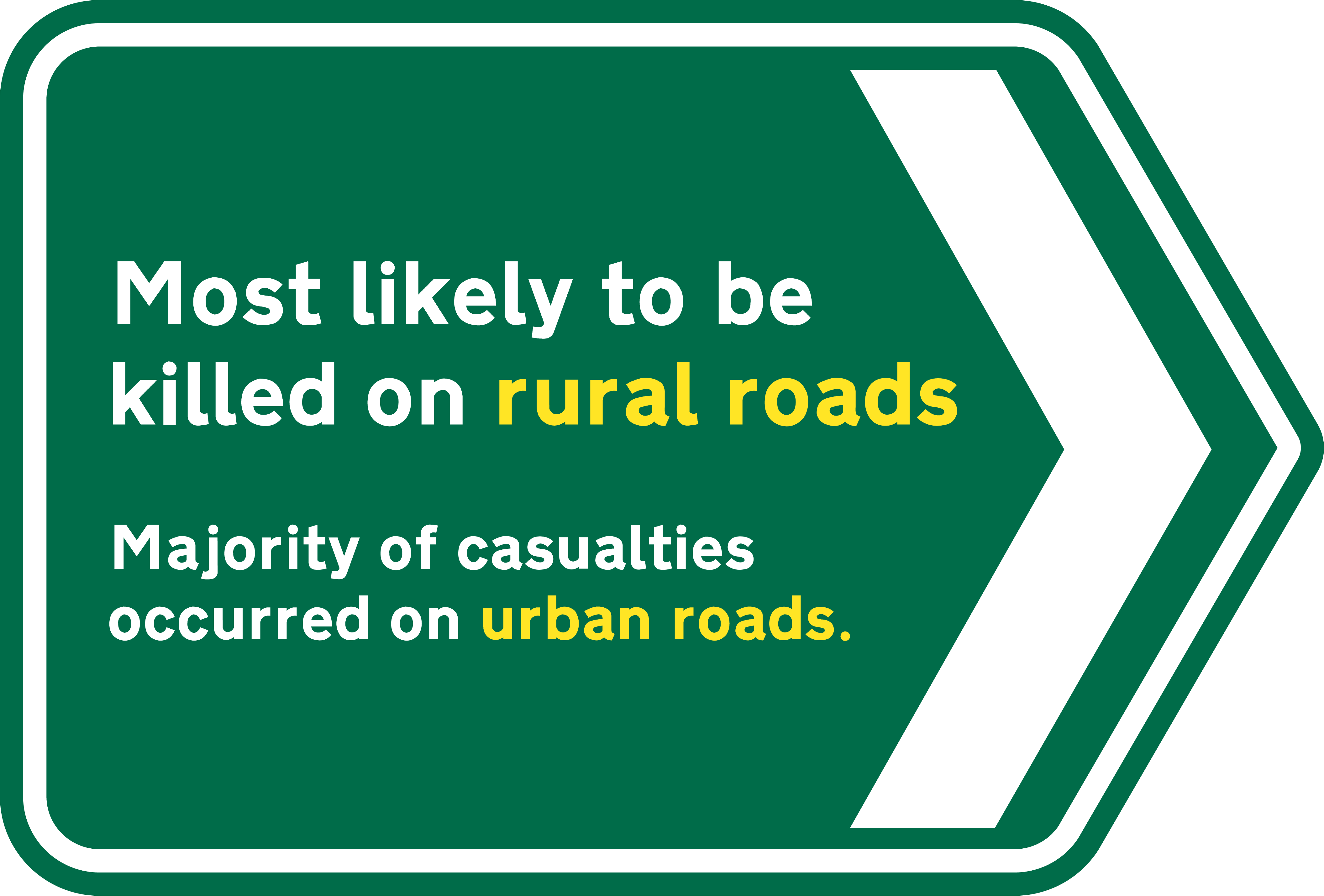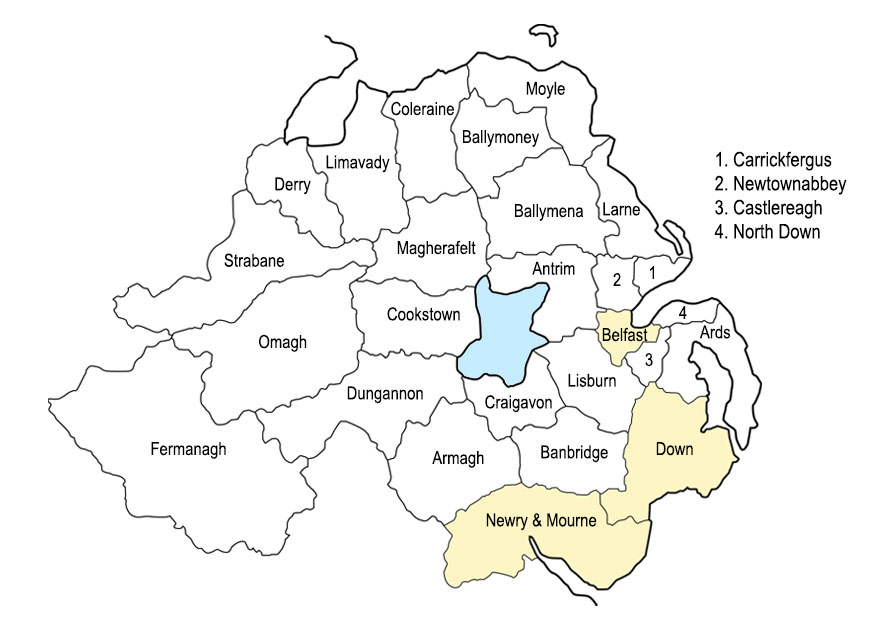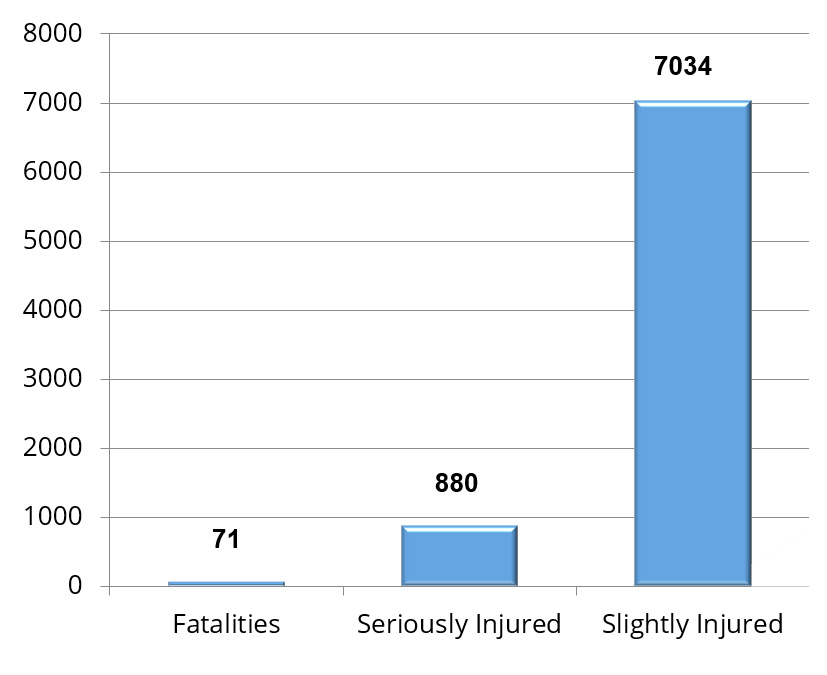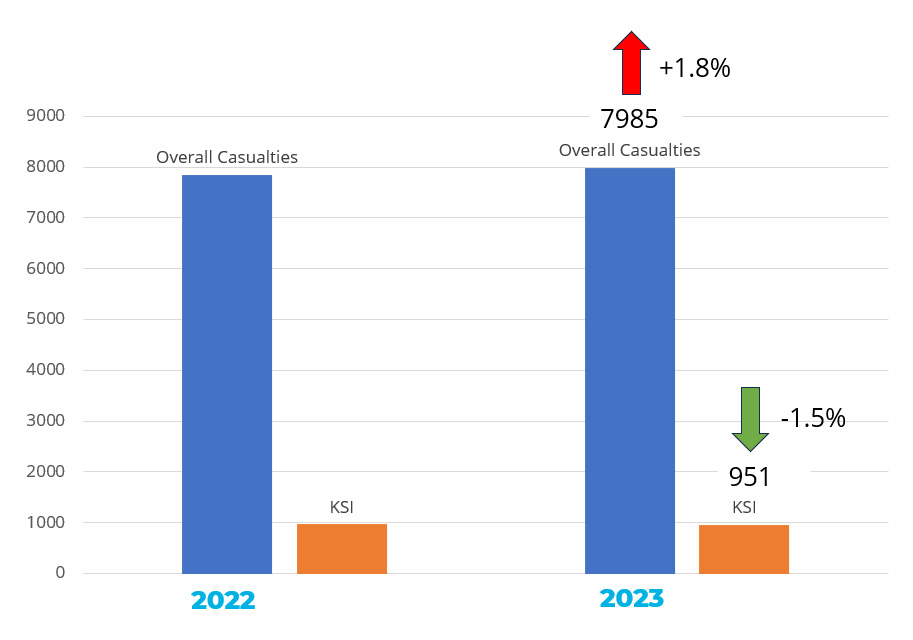At IAM RoadSmart, we aim to inform members of the motoring and riding community, fleet managers and external organisations about the importance of road safety. We do this by producing different resources that inform and educate on the latest policy changes.
We also offer tips, advice, and general guidance to support making the roads a safer place. On this page, you will find a variety of resources explaining different areas of road safety. This includes The Highway Code, alongside tips to help you improve your driving and riding.
The below statistics are from the Department For Transport's annual report surrounding road traffic accidents and casualties. This report was released in September 2023 for the 2022 period. We update this page on an annual basis as new reports come in.
Overall statistics
In in Great Britain in 2023 there were 1,624 fatalities, a decline of 5% compared to 2022. There were 29,711 killed or seriously injured (KSI) casualties, little change compared to 2022 (29,742). And overall there were 132,977 casualties of all severities, a decline of 2% compared to 2022.
Overall statistics
| Killed | KSI | KSIA | All |
|---|---|---|---|
| 1,624 | 28,087 | 29,711 | 132,977 |

Vehicle miles driven
Considering road collision rates per billion miles travelled, the final estimates show:
- 334 billion vehicle miles travelled in 2023, a return to travel levels seen in 2019 before the COVID-19 pandemic.
- 5 road fatalities per billion vehicle miles travelled in 2023, down 7% compared to 2022.
Vehicle miles driven (BVM)
| Cars/Taxi | LCV | HGV | Pedal | Buses/Coach | Motorcycles |
|---|---|---|---|---|---|
| 251.3 | 57.8 | 16.9 | 3.6 | 1.9 | 2.9 |

Casualties by gender
Once again, in 2023 KSI’s on our roads were found to be overwhelmingly male. Overall, in 2023:
- 75% of fatalities and 61% of casualties of all severities were male
- 5% of fatalities and 10% of casualties were aged 16 years old and under
- 23% of fatalities and 29% of casualties were aged 17 to 29 years old
- 22% of fatalities and 8% of casualties were aged 70 years old and over
Casualties by gender
| Sex | Age group (years) | 2023 | % change from 2022 | % change from 2013 |
|---|---|---|---|---|
| Male | 0 to 16 | 7,805 | -2 | -26 |
| Male | 17 to 29 | 24,256 | -3 | -32 |
| Male | 30 to 49 | 26,768 | -3 | -27 |
| Male | 50 to 69 | 15,458 | -2 | -14 |
| Male | 70 and over | 5,015 | -1 | -9 |
| Male | All ages | 79,302 | -2 | -25 |
| Female | 0 to 16 | 5,327 | 0 | -30 |
| Female | 17 to 29 | 12,969 | -5 | -45 |
| Female | 30 to 49 | 16,230 | 0 | -31 |
| Female | 50 to 69 | 10,643 | 0 | -22 |
| Female | 70 and over | 4,768 | 2 | -18 |
| Female | All ages | 49,937 | -1 | -33 |

Casualties by age
As in 2022, the age group with most fatalities were males aged 30 to 49 with 357 fatalities.
For females the age group with the most fatalities were those aged 70 and over (148), a decrease of 3% over the last year.
Casualties by age
| Sex | Age group (years) | 2023 | % change from 2022 | % change from 2013 |
|---|---|---|---|---|
| Male | 0 to 16 | 52 | 33 | 41 |
| Male | 17 to 29 | 307 | -12 | -25 |
| Male | 30 to 49 | 357 | -5 | -2 |
| Male | 50 to 69 | 277 | -5 | 1 |
| Male | 70 and over | 217 | -9 | 17 |
| Male | All ages | 1,210 | -6 | -5 |
| Female | 0 to 16 | 23 | 28 | -18 |
| Female | 17 to 29 | 73 | -1 | -34 |
| Female | 30 to 49 | 67 | -24 | -26 |
| Female | 50 to 69 | 103 | 20 | 47 |
| Female | 70 and over | 148 | -3 | 3 |
| Female | All ages | 414 | -1 | -6 |

Casualties by road type
In 2023, the majority of road fatalities occurred on rural roads, whereas the majority of all casualties occurred on urban roads.
Although motorways account for 21% of road traffic, they account for a much smaller proportion of road fatalities (5%) and casualties (4%).
By contrast, rural road fatalities (60%) are over represented compared to the proportion of rural road traffic (44%). Similarly, urban roads account for a much higher proportion of road casualties (63%) than their relative traffic level (35%).
Casualties by road type
| Severity | Road type | 2023 | % change from 2022 | % change from 2013 |
|---|---|---|---|---|
| Killed | Motorways | 84 | -16 | -16 |
| Killed | Rural roads | 969 | -5 | -9 |
| Killed | Urban roads | 571 | -4 | 5 |
| All casualties | Motorways | 5,279 | -1 | -40 |
| All casualties | Rural roads | 44,241 | 0 | -30 |
| All casualties | Urban roads | 83,452 | -3 | -25 |
| Traffic (billion vehicle miles) | Motorways | 70 | 2 | 10 |
| Traffic (billion vehicle miles) | Rural roads | 148 | 2 | 12 |
| Traffic (billion vehicle miles) | Urban roads | 116 | 2 | 2 |

Seat belt fatalities
In 2023 around a quarter of all car occupants were not wearing seatbelts, but this proportion was higher for male car occupant fatalities and occupants travelling in the evening and night (6pm to 8am).
Seat belt fatalities
| Car Occupant Type | Fatalities Not Wearing a Seatbelt (%) |
|---|---|
| All occupants | 24.6 |
| Female occupants | 11.1 |
| Male occupants | 31.3 |
| Occupants travelling in the daytime (8am to 6pm) | 18.8 |
| Occupants travelling in the evening and night (6pm to 8am) | 37.5 |

Fatalities by location
While overall casualties in Great Britain fell from 2022 to 2023 in the North East, Yorkshire, East and West Midlands and Wales – casualties rose over the last year.
Below is a table showing the number of those killed on roads over the last year across the UK compared to 2022.
Fatalities by location
| Region | 2022 | 2023 |
|---|---|---|
| North East | 54 | 67 |
| North West | 173 | 156 |
| Yorkshire and The Humber | 163 | 169 |
| East Midlands | 175 | 178 |
| West Midlands | 163 | 173 |
| East of England | 206 | 170 |
| London | 103 | 102 |
| South East | 249 | 205 |
| South West | 157 | 150 |
| England | 1,443 | 1,370 |
| Wales | 95 | 101 |
| Scotland | 173 | 153 |
| Great Britain | 1,711 | 1,624 |
| Northern Ireland | 55 | 71 |
| United Kingdom | 1,766 | 1,695 |

Northern Ireland – Last updated: June 2024
Police Service for Northern Ireland data shows:
Calendar year 2024 so far:
As of June 2024, there have been 26 fatalities on Northern Ireland’s roads.
Regions: In 2023, Newry, Mourne and Down district had the highest number of road deaths with 11 fatalities. Belfast City district recorded the most serious injuries in 2023 (127 people).
Data shows the biggest principal causation factors for KSI casualties were ‘inattention or attention diverted’ and ‘impairment by drugs or alcohol - driver/rider’
Drivers and pedestrians represent around three-fifths of all KSI (Killed or Seriously Injured) casualties (59%)

Breakdown of road casualties - Northern Ireland 2023

This resulted in: Total casualties of 7985, 71 fatalities, 880 people seriously injured and 7,034 slightly injured.
Breakdown comparison - Northern Ireland 2022 and 2023

Compared to 2022, overall casualties in 2023 increased by 1.8% to 7985.
The amount of KSI (Killed or Seriously Injured) casualties dropped by 1.5% to 951, however they remain higher than the totals seen prior to Covid-19 in 2020.
Long-term fatalities on NI’s roads by year

Top priorities for motorists in Northern Ireland – IAM RoadSmart Road Safety culture report shows:
The top three issues among Northern Ireland’s motorists are the ‘cost of motoring’, followed by ‘potholes’ and roadworks/road closures.
Contributory Factors in UK
Officers attending the scene of a collision provide an insight into how and why a collision occurs. They are able to select up to 6 factors they believe contributed to a collision for the vehicles and casualties involved. The 3 sections with the largest number of collisions were:
1. Speed
2. Behaviour or inexperience
3. Distraction or impairment
Whilst the overall table of contributory factors to fatal collisions is below:
Contributory Factors
| Road Safety Factor Section | 2023 (%) |
|---|---|
| Speed | 57.7 |
| Behaviour or inexperience | 46.8 |
| Distraction or impairment | 34.9 |
| Road | 12.3 |
| Non-motorised road users | 7.5 |
| Vehicles | 4.2 |
| Not coded | 3.9 |

The Hierarchy of Road Users
Pedestrian Priority
Cyclists and Roundabouts
The 'Dutch Reach'
Sharing with Cyclists
Powdery Check - Bike
Sitting Comfortably
Powdery Check - Car
Driving in Towns
Motorway Driving
Understanding the Hierarchy of Road Users
Observation, Anticipation and Planning
How To Effectively Manage Distractions
Breaking the Cycle of Conflict
Understanding Stopping Distance

